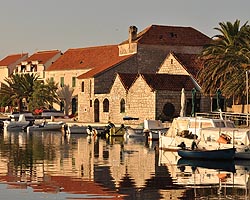Jelsa - information and photos
Jelsa is a small town situated in a bay on the northern coast of the central part of the island of Hvar. It borders with the two highest peaks on the island: St. Nicolas on the west and Hum on the east. Jelsa consists of two main parts: Vela Banda on the southern coast and Mala Banda on the northern.
Jelsa is an important tourist centre which has a rich tradition in tourism (the oldest hotel Jadran was built in 1911). The town is also well-known for its quality red wine for a long time ago. Major attractions include cultural and entertainment programs, various accommodation facilities (hotels, apartments, campsites, private rooms...), sports and recreational opportunities (football, basketball, volleyball, tennis, miniature golf, boccia, water sports, diving school...), gastronomic offer (fresh sea-food and famous wines) and excursions (to Bol on the island of Brac, to Makarska and to other places on the island of Hvar). Guests can rent motorboats, speedboats, bicycles, motorcycles or cars.
Jelsa has a coast line with numerous bays on which guests can find peace and pleasure. Tourists are attracted to the sandy, gravel and rocky beaches.
The most popular beaches in Jelsa are:
Mina beach - a sandy beach with a restaurant, about 500 m far away from the centre, ideal for children.
Grebišće - a sandy beach with a restaurant and a beach club, about 1.5 km far away from Jelsa.
Zenčišća - a beach situated 3 km east from Jelsa.
Bočić - a swimming place situated 300 m far away from the centre of Jelsa.
Bay of St. Luke (or Crkvica) - a pebble beach 4 km east from Jelsa (also an archeological site).
On the hill above Jelsa there is Tor, a massive fortification built of huge regular shaped blocks of stone joined without mortar. It was a Greek observation point, which stands on an older Illyrian fort. This fort is from the ancient period and it was of great importance in the Middle Ages. Jelsa was being developed since the 14th century as the port of Pitve, the village 3 km far away from the sea. Jelsa developed especially in the 19th century, due to shipbuilding and navigation. This conditioned its urban expansion and its acquisition of the main role on the central part of the island.
Jelsa has numerous cultural and historical monuments. The most famous are:
Church of St. Mary’s Assumption (from 1331), today the parish church.
Our Lady of Health Church built in 1535 at the top of Racic hill. The hill itself offers a beautiful view of valley and the port.
The Church of St. Rock built in the second part of the 16th century.
The Church of St. Michael built in 1463.
Lapidary (a collection of stone monuments) contains about twenty stone monuments dating back from ancient and mediaeval times.
Perivoj (public garden) - one of the largest and most beautiful parks in Dalmatia, created in 1870 on alluvial terrain. The large poplars, pine and palm trees, acacias and oleanders, bay laurel and other Mediterranean plants add to the beauty of the park.
Pjaca (main square) is situated in the centre of Jelsa. On the west side of the square there is a natural water spring, also known as the small river Slatina, which has been used by the local inhabitants since the ancient times.
Square of St. John is one of the most beautiful squares from the Renaissance-Baroque era, with a small octagonal St. John church from the end of the 15th century.
Small church of St. Luke is in the cove 4 km from Jelsa. In this area there are remains from the Roman period.








 English
English  Hrvatski
Hrvatski  Deutsch
Deutsch  Italiano
Italiano  Polski
Polski  Čeština
Čeština  Slovenčina
Slovenčina  Slovenščina
Slovenščina 






























